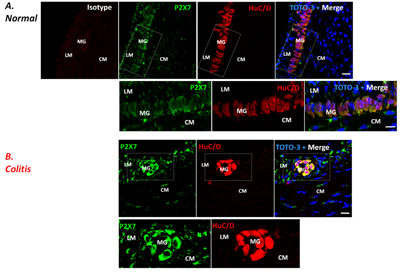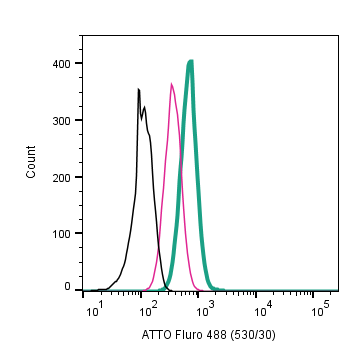Overview
- Peptide KKGWMDPQSKGIQTGRC, corresponding to amino acid residues 136-152 of mouse P2X7 receptor (Accession Q9Z1M0). Extracellular loop.

- Mouse muscle-myenteric plexus sections (1:100) (Caputi, V. et al. (2017) Front. Pharmacol. 8, 350.).
- Ding, Y. et al. (2000) J. Auton. Nerv. Syst. 81, 289.
- Kim, M. et al. (2001) EMBO J. 20, 6347.
- Chizh, B.A. and Illes, P. (2001) Pharmacol. Rev. 53, 553.
- Nihei, O.K. et al. (2000) Mem.Inst.Oswaldo Cruz. 95, 415.
The P2X7 receptor is a member of the ionotropic P2X receptor family that is activated by ATP. To date, this family is composed of seven cloned receptor subtypes, named P2X1-P2X7.
The different P2X receptors show distinct expression patterns. P2X1-6 have been found in the central and peripheral nervous system, while the P2X7 receptor is found in cells of the immune system, particularly antigen presenting cells, and microglia. The P2X7 receptor mediates the release of proinflamatory cytokines, stimulation of transcription factors and may also have an important role in apoptosis.1-3
Different techniques have been used to characterize the P2X7 receptor. Most of them investigated pores, ion channels (electrophysiology) and membrane alterations (calcium microfluorometry, dye uptake, membrane depolarization and ion influx analysis). With the introduction of flow cytometry, it is now possible to analyze multiple cell parameters such as cell cycle, cell membrane alteration, calcium influx and cell phenotype.4
Application key:
Species reactivity key:
Anti-P2X7 Receptor (extracellular) Antibody (#APR-008) is a highly specific antibody directed against an epitope of the mouse protein. The antibody can be used in western blot, indirect flow cytometry, immunohistochemistry, live cell imaging, and immunocytochemistry applications. It has been designed to recognize P2X7 purinergic receptor from mouse, rat, and human samples.
Anti-P2X7 Receptor (extracellular)-ATTO Fluor-488 Antibody (#APR-008-AG) is directly labeled with an ATTO-488 fluorescent dye. ATTO dyes are characterized by strong absorption (high extinction coefficient), high fluorescence quantum yield, and high photo-stability. The ATTO-488 label is analogous to the well known dye fluorescein isothiocyanate (FITC) and can be used with filters typically used to detect FITC. Anti-P2X7 Receptor (extracellular)-ATTO Fluor-488 Antibody is specially suited to experiments requiring simultaneous labeling of different markers.

Expression of P2RX7 in rat colon.Immunohistochemical staining of rat distal colon section using Anti-P2X7 Receptor (extracellular)-ATTO Fluor-488 Antibody (#APR-008-AG). A. P2X7 staining (green) in normal colon sections co-localizes with that of HuC/D (red). B. P2X7 staining in the presence of colitis is detected in the neuromuscular layer and expression of the receptor is increased in myenteric ganglia. TOTO-3 (blue) was used to stain nuclei.Adapted from Antonioli, L. et al. (2014) PLoS One 9, e116253. with kind permission of Dr. Colucci, R. Div. Pharmacology and Chemotherapy, Dept. of Clinical and Experimental Medicine, University of Pisa Pisa, Italy.
Applications
Citations
 Expression of P2X7 receptor in mouse longitudinal muscle-myenteric plexus sections.Immunohistochemical staining of mouse longitudinal muscle-myenteric plexus sections using Anti-P2X7 Receptor (extracellular)-ATTO Fluor-488 Antibody (#APR-008-AG). P2X7 receptor staining (yellow) is detected in myenteric neurons.
Expression of P2X7 receptor in mouse longitudinal muscle-myenteric plexus sections.Immunohistochemical staining of mouse longitudinal muscle-myenteric plexus sections using Anti-P2X7 Receptor (extracellular)-ATTO Fluor-488 Antibody (#APR-008-AG). P2X7 receptor staining (yellow) is detected in myenteric neurons.
Adapted from Caputi, V. et al. (2017) Front. Pharmacol. 8, 350. with permission of Frontiers.
- Western blot analysis of mouse neutrophil lysate using #APR-008. Tested in P2X7-/- mice.
Karmakar, M. et al. (2016) Nat. Commun. 7, 10555.
- Mouse muscle-myenteric plexus sections (1:100).
Caputi, V. et al. (2017) Front. Pharmacol. 8, 350.


